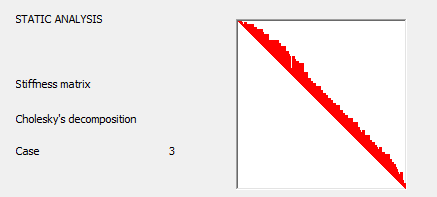The frontal method solves the K * x = b linear equation system.
The stiffness matrix K is decomposed (frontal decomposition) into the two matrices K = L * U (Gauss elimination procedure).
This method is based on element-by-element aggregation of the matrix ![]() and the simultaneous elimination of fully assembled equations 12. In this method, Nele denotes a number of finite elements, and Ke is the relevant element matrix.
and the simultaneous elimination of fully assembled equations 12. In this method, Nele denotes a number of finite elements, and Ke is the relevant element matrix.
The frontal method does not implement a fully assembled matrix. A dense work array (front) consisting of fully assembled equations (top front) and partially assembled equations (bottom front) slides along the matrix. Decomposed equations present the upper triangle matrix U and are stored in the secondary storage immediately after completing the corresponding elimination.
The frontal method is available only if the load case list does not include an eigenvalue (modal and buckling) analysis.
Specifications
- Memory use: low.
- Disk use: high.
- Speed estimation: slow.
- Quantity of equations: up to 50000 equations.
- Supported analyses: Linear and non-linear statics, harmonic analysis.
- Available analysis limitations: N/A.
- Additional remarks: The frontal method often allows you to obtain numbers of nodes and degrees of freedom for equations leading to calculation problems such as incorrectly restricted structures.
Frontal Method calculations
-
- Model reduction (renumbering of nodes and elements)
- Definition of the stiffness matrix for individual structure elements
- Matrix decomposition (frontal decomposition) K = L * U
- Problem solving for successive load cases.
